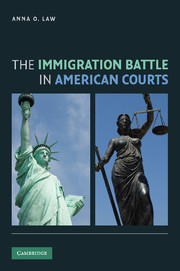Book contents
- Frontmatter
- Contents
- List of Tables and Figures
- Acknowledgments
- 1 Introduction
- 2 How Do We Know What We Know? Data, Methods, and Initial Findings
- 3 The Rise of Two Courts with Differentiated Functions
- 4 Interstitial Policy Making in the U.S. Courts of Appeals
- 5 Institutional Growth and Innovation: The Ninth Circuit Court of Appeals and Immigration
- 6 Continuity Amid Change: The Federal Courts' Commitment to Due Process
- 7 Conclusion
- Appendix A Further Elaboration of Case Selection Methods
- Appendix B Further Elaboration on the Search for Modes of Legal Reasoning
- Appendix C Numerical Codes for Modes of Legal Reasoning
- Appendix D Interview Questions
- Index
- References
5 - Institutional Growth and Innovation: The Ninth Circuit Court of Appeals and Immigration
Published online by Cambridge University Press: 04 August 2010
- Frontmatter
- Contents
- List of Tables and Figures
- Acknowledgments
- 1 Introduction
- 2 How Do We Know What We Know? Data, Methods, and Initial Findings
- 3 The Rise of Two Courts with Differentiated Functions
- 4 Interstitial Policy Making in the U.S. Courts of Appeals
- 5 Institutional Growth and Innovation: The Ninth Circuit Court of Appeals and Immigration
- 6 Continuity Amid Change: The Federal Courts' Commitment to Due Process
- 7 Conclusion
- Appendix A Further Elaboration of Case Selection Methods
- Appendix B Further Elaboration on the Search for Modes of Legal Reasoning
- Appendix C Numerical Codes for Modes of Legal Reasoning
- Appendix D Interview Questions
- Index
- References
Summary
Having examined how institutions originate and some of the factors that cause them to evolve over time, one finds that the U.S. Supreme Court and the U.S. Courts of Appeals, as institutions, developed along parallel but distinct paths. In this chapter, I posit that scholars of institutional development must not only be aware of the important contextual differences between the U.S. Supreme Court and the U.S. Courts of Appeals, but they must also be sensitive to the causes and effects of uneven institutional development within the same level of the federal courts, such as in the U.S. Courts of Appeals system. Beginning in 2002, the Second and Ninth Circuits experienced a sharp and sudden spike in their immigration caseloads. What happens to an institution and its occupants when it is forced to adopt new procedures and processes to cope with a sharply rising caseload? In the set of interviews conducted for this study, several of the Ninth Circuit Courts of Appeals judges insisted that a sharp rise in caseloads does not alter the way they decide cases or otherwise do their jobs, even as the institution must make adjustments and accommodations for the increase. Despite the judges' protestations to the contrary, and consistent with the theory perpetuated throughout this book, a change in institutional context recalibrated the adjudicative procedures within the Ninth Circuit and reshaped the range and opportunities for purposive behavior available to the judges.
- Type
- Chapter
- Information
- The Immigration Battle in American Courts , pp. 144 - 187Publisher: Cambridge University PressPrint publication year: 2010



